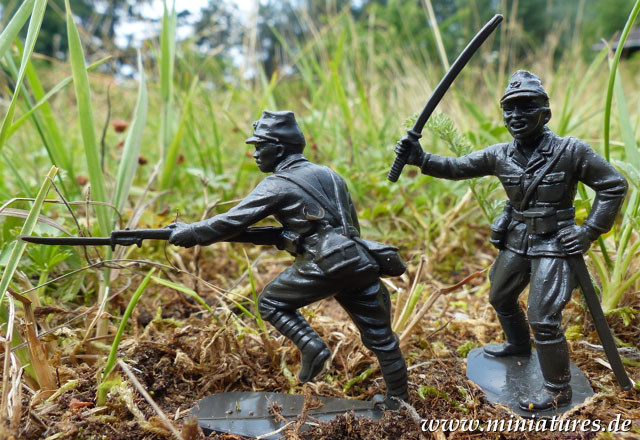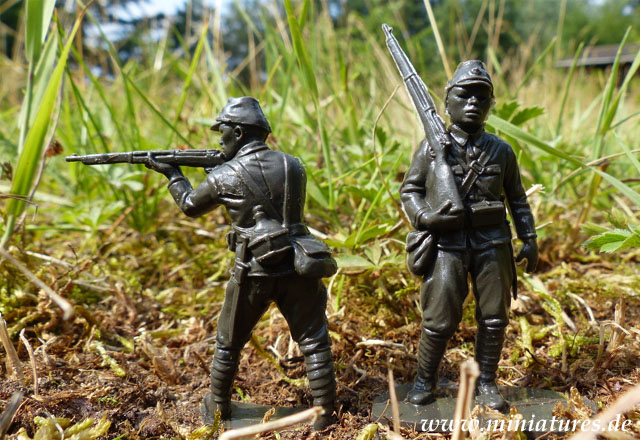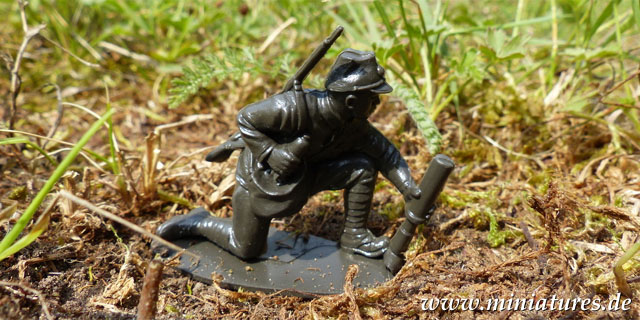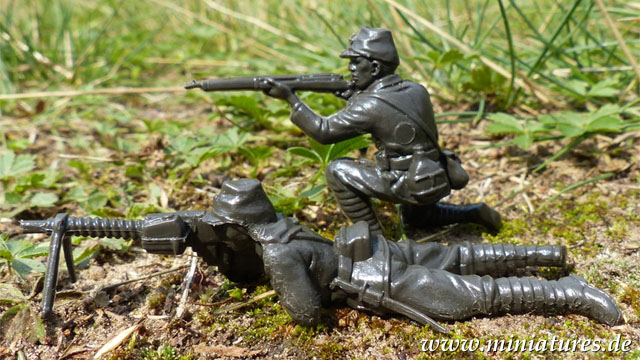Japanese Infantry
Airfix 1:32 Scale Miniatures Review

Airfix 1:32 scale Japanese Infantry offers well proportioned and beautifully sculpted miniatures which appear quite authentic at first glance. But, the devil is in the details: not one of the seven different soldiers is properly dressed and accoutered by military standards.
Contents
14 Figures in 7 Poses – 52 mm equal 166 cm Height
- Japanese Officer with (Shin Gunto) Type 98 Army Sword (1)
- Japanese Soldier with Type 89 Grenade Discharger (2)
- Japanese No. 1 Machine Gunner with Type 11 (Nambu) LMG (2)
- Japanese Soldier with Type 38 Arisaka Rifle, marching (2)
- Japanese Soldier with Type 38 Arisaka Rifle, charging (2)
- Japanese Soldier with Type 38 Arisaka Rifle, standing, firing (2)
- Japanese Soldier with Type 38 Arisaka Rifle, kneeling, firing (3)
Evaluation
Airfix Japanese soldiers are excellent figures in their own right, with consistently realistic poses, interesting faces, natural folds in clothing, and detailed equipment. They are wearing the “98 Shiki-Gun-i” (1938) uniform with straight pocket flaps on the field jacket, trousers (»Bousyo-ko«) with puttees (»Kya-han«), field cap (»Sen-bou«), and ankle boots (»Amiage-gutu«), or riding breeches and boots for the officer. Side pockets are not in evidence on any one of the figures. Instead of flap pockets, Airfix gave these soldiers buttoned-flap patch pockets. The hem of the field jacket and the sleeves are decorated with pretty piping, which unfortunately did not exist. The rank and file are wearing their differently cut collars closed; the officer wears his collar of the field jacket open, and the collar of the shirt above that.

The bread bag and water bottle were carried on straps over the left shoulder so that the water bottle rested on the bread bag. The officer and machine gunner are the only ones who have their water bottle properly slung across their shoulders, but both are without a bread bag. The other soldiers carry the bread bag on the right and the water bottle on the left, or at the center of the back, where the large cartridge pouch for reserve ammunition should be carried.

The Japanese soldier carried three cartridge pouches, two with 30 cartridges each at the front of the waistbelt, as well as a large pouch for 60 cartridges of reserve ammunition at the back of the belt. The riflemen only have the two smaller cartridge pouches, the machine gunner only carries the rear one.
Edged weapons are worn on the left, to be drawn with the right hand (with the exception of the Roman “Gladius”, which was carried on the right to avoid collision with the heavy “Scutum” shield). Two of the Airfix riflemen do carry the bayonet on the left, two carry it on the right, and one does not have a bayonet at all. Instead, the light machine gunner has a bayonet, even though his Type 11 light machine gun could not have a bayonet attached to it. Please refer to our tutorial “Japanese Infantry Conversions” to see how we correct these mistakes.

Interestingly, Airfix subsequently added the light machine gunner to their 1:76 scale Japanese Infantry figure set, the first edition of which did not have a machine gunner. To make space in the mould, a prone rifleman was eliminated. Unfortunately, the other six 1:32 scale Japanese soldiers were not transferred to the smaller figure set. However, there are cheap 1:72 scale reproductions of these Japanese Infantry Made in Hong Kong.
The officer is missing the pistol, pistol cartridge pouch, map case and gas mask bag. The small pocket at the front of the waistbelt might contain opera glasses, but probably not binoculars. The front of the field cap should be adorned with a flat, yellow, five-pointed star, which on these figures is designed as a cross on a roundel or as a hemisphere.
Noticeable mould lines need to be removed prior to painting. In addition, it is well worth repairing the above-mentioned mistakes in the equipment with Green Stuff before investing valuable time into painting.
Japanese Infantry Painting Guide
The Airfix Japanese Infantry Painting Guide recommends 18 Humbrol paints, several of which simply cover variants of three different uniforms: an officer‘s tropical uniform, and the enlisted man‘s mustard-coloured or olive green “98 Shiki-Gun-i” (1938) uniform. While it makes perfect sense to vary the colours of an officer‘s privately purchased field uniform, such variations are easily achieved by mixing, tinting, and shading available colours, without having to purchase so many additional pots of paint. While olive green field jackets may have been worn with mustard-coloured trousers on campaign, and vice versa, the Airfix painting guide elevates this field expedient to a rule, rather than an exception.
- Humbrol 11 »Silver«: Sword, Bayonet
- Humbrol 33 »Black«: Hair, Bayonet Scabbard
- Humbrol 34 »White«: Officer‘s Shirt
- Humbrol 53 »Gun Metal«: Rifle and Machine Gun Barrels
- Humbrol 61 »Flesh«: Faces and Hands
- Humbrol 62 »Leather«: Shoes and Boots
- Humbrol 72 »Khaki Drill«: Officer‘s Field Cap
- Humbrol 78 »Cockpit Green (RAF)«: Puttees
- Humbrol 80 »Grass Green«: Base
- Humbrol 83 »Ochre«: Cotton Shirt, Soldier‘s Field Cap
- Humbrol 84 »Mid Stone«: Haversack and Strap
- Humbrol 98 »Chocolate«: Bayonet Handle
- Humbrol 102 »Army Green«: Officer‘s Tropical Field Jacket
- Humbrol 103 »Cream«: Field Cap Insignia, not!
- Humbrol 159 »Khaki Drab«: Field Jacket
- Humbrol 168 »Hemp«: Trousers
- Humbrol 186 »Brown«: Rifle Stock, Ammunition Pouches
- Humbrol 187 »Dark Stone«: Trousers
The five-pointed star on the field cap (»Sen-bou«) should be yellow, not cream-coloured. Boots and shoes can be black, or the same dark brown colour as the ammunition pouches. If matching colours for the field jacket and trousers are used, the uniforms are either mustard-coloured or olive green, not both.